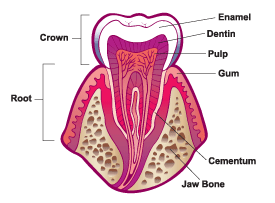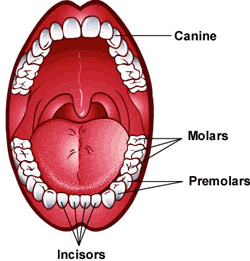13.- TEETH
You bite into an apple and then try to start talking to your friend about yesterday’s math homework. Suddenly something feels funny — one of your baby teeth has fallen out! It’s been loose forever, and now there it is, right in your hand. And you have an empty space in your mouth big enough to poke a drinking straw through.
Before you put that tooth under your pillow, did you know that there is much more to that tooth than meets the eye? A single tooth has many different parts that make it work. And teeth play an important role in your daily life. They not only let you eat stuff like apples, they also help you talk. So let’s talk teeth!
Tiny Teeth
Unlike your heart or brain, your teeth weren’t ready to work from the day you were born. Although babies have the beginnings of their first teeth even before they are born, teeth don’t become visible until babies are about 6 to 12 months old.
After that first tooth breaks through, more and more teeth begin to appear. Most kids have their first set of teeth by the time they are 3 years old. These are called the primary or baby teeth, and there are 20 in all. When a child gets to age 5 or 6, these teeth start falling out, one by one.
A primary tooth falls out because it is being pushed out of the way by the permanent tooth that is behind it. Slowly, the permanent teeth grow in and take the place of the primary teeth. By about age 12 or 13, most kids have lost all of their baby teeth and have a full set of permanent teeth.
Tooth Tour
Let’s take a tour of your teeth. Look in the mirror at your own teeth or check out a friend’s smile. The part of the tooth you can see, which is not covered by the gum (your gums are the pink, fleshy part), is called the crown. The crown of each tooth is covered with enamel (say: ih-nam-ul), which is very hard and often shiny. Enamel is a very tough substance and it acts as a tooth’s personal bodyguard. Enamel works as a barrier, protecting the inside parts of the tooth.
 If you were able to peel away the enamel, you would find dentin (say: den-tin). Dentin makes up the largest part of the tooth. Although it is not as tough as enamel, it is also very hard.
If you were able to peel away the enamel, you would find dentin (say: den-tin). Dentin makes up the largest part of the tooth. Although it is not as tough as enamel, it is also very hard.
Dentin protects the innermost part of the tooth, called the pulp. The pulp is where each tooth’s nerve endings and blood supply are found. When you eat hot soup, bite into a super-cold scoop of ice cream, fall and hurt a tooth, or get a cavity, it’s your pulp that hurts. The nerve endings inside the pulp send messages to the brain about what’s going on ("That ice cream is too cold!"). The pulp also contains the tooth’s blood vessels, which feed the tooth and keep it alive and healthy.
The pulp goes all the way down into the root of the tooth, which is under the gum. Cementum (say: sih-men-tum) makes up the root of the tooth, which is anchored to the jawbone.
There are 28 permanent teeth in all — eight more than the original set of baby teeth. Between the ages of 17 and 21, four more teeth called wisdom teeth usually grow in at the back of the mouth. They complete the adult set of 32 teeth.
Tooth Types
You’ve probably noticed that you have different types of permanent teeth in your mouth. Each one has its own function.
Your two front teeth and the teeth on either side of them are incisors (say: in-sy-zurs). There are four on the top and four on bottom.
 Incisors are shaped like tiny chisels, with flat ends that are somewhat sharp. These teeth are used for cutting and chopping food. Think back to that apple you ate: You used your incisors to crunch into the skin of the apple.
Incisors are shaped like tiny chisels, with flat ends that are somewhat sharp. These teeth are used for cutting and chopping food. Think back to that apple you ate: You used your incisors to crunch into the skin of the apple.
The pointy teeth beside your incisors are called canine (say: kay-nine) teeth. There are four of them, two on top and two on bottom. Because these teeth are pointy and also sharp, they help tear food.
Next to your canine teeth are your premolars (say: pree-mo-lurs), which are also called bicuspid teeth. You have eight premolars in all, four on top and four on the bottom. You’ll need to open a bit wider to see these teeth, but when you do, you’ll notice that their shape is completely different from both incisors and canines. Premolars are bigger, stronger, and have ridges, which make them perfect for crushing and grinding food.
If you open your mouth really wide, you’ll see your molars (say: mo-lurs). You have eight of these, four on the top and four on the bottom. Sometimes these are called your 6-year molars and your 12-year molars because that is around the time when they come in.
0 comentarios